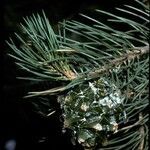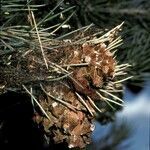An evergreen pine tree. It grows 15 m high and is a broad cone shape. The bark is grey and has narrow ridges. The leaves are needle like and rigid and curved. They are 5 cm long and taper to a sharp point. They occur singly and are grey-green. They are on stout orange shoots. The flowers occur in separate clusters on young shoots. Male flowers are yellow and female flowers are red. The fruit is a cone 5.5 cm long. It is green but ripens to grey-brown.



